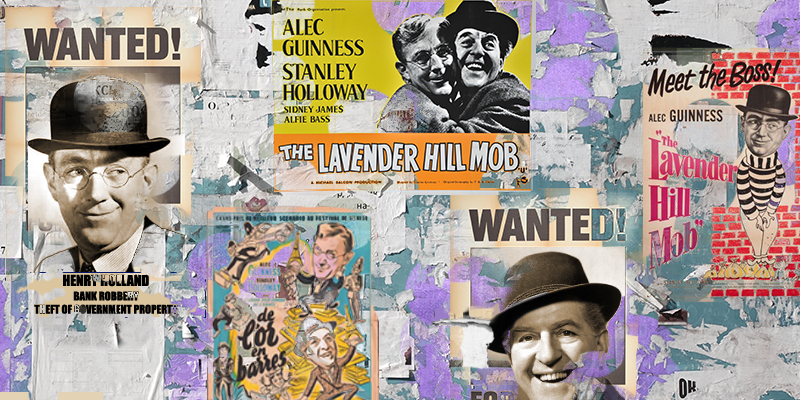The Lavender Hill Mob, which was made in 1951, is a film of endless charm and joy. It is a caper, which is (in my opinion) the best genre. And it was made by Ealing Studios, an English production company that was formally established in 1929, though on a site that had been home to different filmmaking companies since 1902. From 1929 through the end of World War II, the studio was known for making both comedy films and war documentaries, but in 1947, it discovered a kind of narrative and stylistic niche, really sensibility, that would lead to the creation of its masterpieces and cemented it as a cornerstone of British cinema.
The film that was made in 1947 was a comic, vaguely crimey adventure called Hue and Cry, a story about kids who find themselves on a great adventure in bombed-out postwar London. But the films that followed, especially three that came out in 1949—Alexander Mackendrick’s Whiskey Galore!, Henry Cornelius’s Passage to Pimlico, and Robert Hamer’s Kind Hears and Coronets—helped shape the tone of this niche, even further. Ealing Studios chiefly produced films that were invested in exploring Britishness; rather, exploring facets of British identity through exaggerations of associated themes, such as class, war trauma, and emotional repression.
The Lavender Hill Mob is about that last thing. Directed by Charles Crichton, written by T.E.B. “Tibby” Clarke, one of Ealing’s best and most prolific writers (who won the Academy Award for his screenplay), it is the story of, in the words of scholar Terry Williams, “the repressed fantastic.”
It is about two men, neighbors in the small Battersea London neighborhood of Lavender Hill, who become unlikely collaborators, compatriots, and friends by giving into their desires and pursuing a life of crime. Our hero is a mild-mannered bank transfer agent played by Alec Guinness (known best by younger generations for playing Obi Wan in the original Star Wars), and a frustrated artist played by Stanley Holloway (best known as playing Alfred Dolittle in My Fair Lady), who team up to commit an extraordinary heist.
The Lavender Hill Mob is about finding an alternative to one’s own life and living that instead.
Guinness (who would star in several Ealing films—the aforementioned Kind Hearts and Coronets, The Man in the White Suit from 1952, and The Ladykillers from 1955) is our antihero Henry Holland. He has dutifully worked for the bank for two decades, facilitating the transfer of gold bullion from foundry to vault, every week. Holloway is Alfred Pendlebury, who dreams of being a sculptor but has to settle for carving stone in his off-hours; his day job is making lead souvenir statues. But it’s not long before Holland realizes that, if one wanted to smuggle stolen gold out of the country, all they’d have to do is melt and smelt it into figurines and ship them abroad.
Holland knows that, even if he gets promoted, he’ll never ever make enough money to live a good life. Pendlebury knows he’ll never make it as an artist. So, the realization of an easy smuggling opportunity gives them both a new raison d’être. But they’re going to need help, so they pretend to be tough-guys and enlist the help of two criminals (Alfie Bass and Sidney James), forming a bank robbing gang for the ages.
Both men are seeking, in different degrees of awareness, a reprieve from the repressive grind of their lives, of their world. Williams calls their desire “freedom from British stagnation and creative frustration.” He cites an example, a scene in which Holloway’s character does a mock interpretation of Richard the Third while making a bust, quoting , “Of all words of tongue and pen… The saddest are these… It might have been me… “Slave. I have set up my life as a cast.” This exemplifies how his anxieties about a lost and ignominious future are tired up in a visage of Britishness. It makes sense then, that a symbol of their long-elusive freedom winds up manifesting as the opposite of being British, which is to say, as looking quite French.
This is to say, they plan that, after they manage to rob the gold from the bank (which is no simple feat, on its own), they’ll melt it into miniature Eiffel Tower figurines and load them on a boat to France. In doing so, they give themselves their first vacation, a rip-roaring sightseeing opportunity up and down France (horizontally as well as vertically… you’ll see what I mean). Holland and Pendlebury quickly become dear friends—thick as, shall we say, thieves. They embrace passionately several times. They laugh hysterically as they chase a mark down the Eiffel Tower staircase. They even rename themselves, with Pendlebury choosing the nickname “Al” and Holland choosing, of all things, “Dutch.” The surprise of this moniker suggests that perhaps Holland has had more dreams, fantasies, alter-egos inside him than his staid career path might suggest. Indeed, The Lavender Hill Mob is about finding an alternative to one’s own life and living that instead. It is also a love story; of loving oneself, one’s friends, and also one’s own life.
There are many magical tidbits sprinkled through, including a tiny appearance by a young, pre-fame Audrey Hepburn, and a young, pre-fame Robert Shaw. And, doubly exciting for you Lucasfilm fans, the cinematography was done by Douglas Slocumbe, who was the director of photography on all three original Indiana Jones films.
But there is great magic not just in these little funny details. The Lavender Hill Mob is in a way about finding the underside of magic in everything—work, friendship, even, of all things, crime.












More Stories
6 Crime and Horror Books Featuring Unusual Narrators
The Ending Of ‘Presumed Innocent’ Gives Carolyn Polhemus A New Killer
Book Release: Night Work by Pete Duval